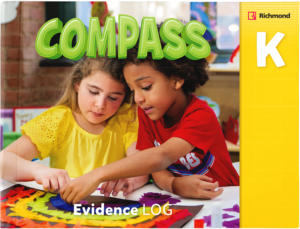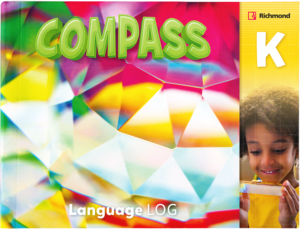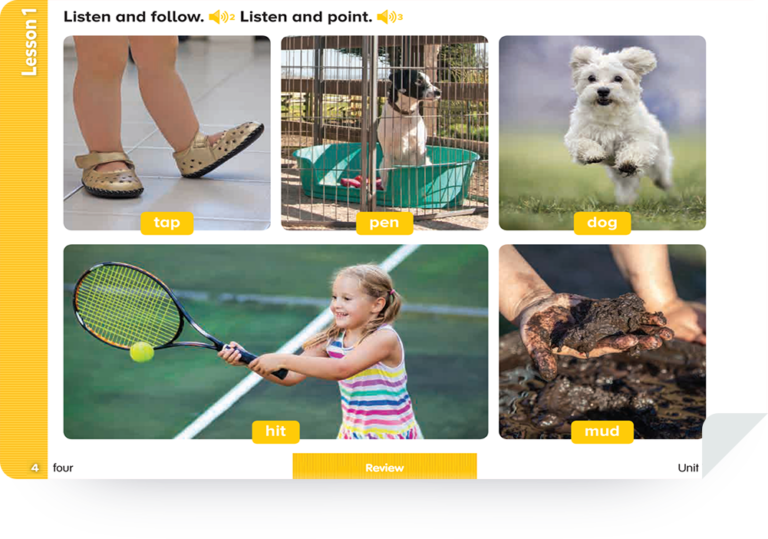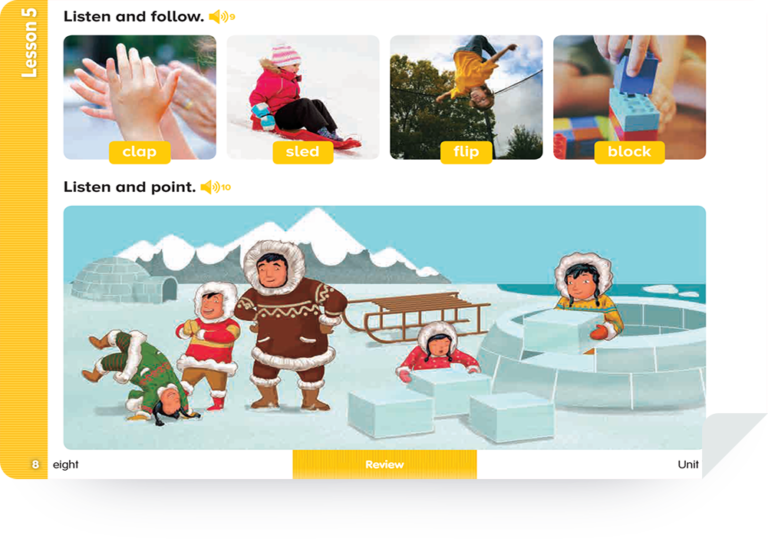Compass K (Digital)
-
Hours per week 10-15+
-
Levels 3
-
American English
Compass K precedes Compass Starter-6 and has a similar inquiry-based focus. It’s a modular English Language program for preschool students with four integrated core components (Project Log, Evidence Log and Language Log for students, and Bonding Booklet for families) and two optional components (Phonics Log and Stories). Its methodology, based on The Project Approach, is perfectly adapted to the curious, experimental nature of preschool children. Each project includes STEAM (Science, Technology, Engineering, Arts and Mathematics) and HSS (Health and Social Studies) content based on US State Standards.
The Compass K Learning Platform uses innovative digital features to promote digital and technological literacy in very young learners, including turtle early-programming activities and educational video games.
-
Sample unit
-
Scope & sequence
With Compass K, students will:
- carry out investigations of real-world, developmentally-appropriate topics that will help them make sense of the world they live in.
- develop their natural curiosity in safe, meaningful contexts, through collaboration and rich social interactions.
- be encouraged to question, observe, communicate, problem-solve and reflect.
- learn and apply early STEAM, HSS and digital knowledge and skills through integrated, challenging, real-life content.
- discover more about themselves, including confidence and motivation, and learn to understand others.
Components and resources

Project Log

Evidence Log

Language Log

Phonics Log

Stories

Learning Platform
Learn more about Compass K (Digital): Project Log
Compass K has three interrelated core modules. The Project Log takes students through the three phases of each project: initial understanding, investigation and a final display.

Phase 1: Prior knowledge
Thought-provoking photographs with recorded captions prompt students to express their prior knowledge and experience of the project topic, and suggest answers to the questions they will investigate in Phase 2.

Davy and Friends Cartoons
After Phase 1, students watch a cartoon featuring Davy the Amazon parrot, who appears throughout Compass with his rainforest friends Zena the jaguar, Buffy the river dolphin and Sid the monkey. Episodes introduces us to the topic, vocabulary and some project questions.

Phase 2: Investigation
Students investigate their answers to the Phase 1 questions, corroborating their prior knowledge and extending their learning through practical activities and experiments. During each part of this phase – Reading, Science, Technology and Engineering, Arts, Math, Health and Social Studies – students produce evidence of their learning for Phase 3

Phase 3: Expert Interviews
During Phase 3, students watch a video where the Project Log children interview an expert: a biologist, librarian, baker, etc. The video and comprehension activities in the Project and Language Logs guide students to review and extend their acquired knowledge.

Language skills
Students learn language and vocabulary to express their initial understanding and suggest answers to the questions; to help them carry out and record results of their investigations and experiments, field trips and visitor interviews; and to present evidence of their learning and reflection in the final display.
Learn more about Compass K (Digital): Evidence Log
Compass K has three interrelated core modules. In the Evidence Log, students first demonstrate what they already know and then what they learn throughout the project before this evidence is used in the final display.

Phase 1: Prior knowledge
Thought-provoking photographs with recorded captions prompt students to express their prior knowledge and experience of the project topic, and suggest answers to the questions they will investigate in Phase 2.

Phase 2: Investigation
Students investigate their answers to the Phase 1 questions, corroborating their prior knowledge and extending their learning through practical activities and experiments. During each part of this phase – Reading, Science, Technology and Engineering, Arts, Math, Health and Social Studies – students produce evidence of their learning for Phase 3.
Learn more about Compass K (Digital): Language Log
In the Language Log, students listen to, speak, read and write language that they will use to carry out the activities in each project. Before students begin investigating different projects, they learn engaging songs and chants to support ten essential Routines they will carry out during the school year. Compass K projects focus on Teeth, Safety Gear, Ants, Books, Bread and Cars.

Phase 1: Prior knowledge
Thought-provoking photographs with recorded captions prompt students to express their prior knowledge and experience of the project topic, and suggest answers to the questions they will investigate in Phase 2.

Phase 2: Investigation
Students investigate their answers to the Phase 1 questions, corroborating their prior knowledge and extending their learning through practical activities and experiments. During each part of this phase – Reading, Science, Technology and Engineering, Arts, Math, Health and Social Studies – students produce evidence of their learning for Phase 3.
Learn more about Compass K (Digital): Phonics Log
This component complements the core modules of the Compass K program by supporting students as they begin to read and write. The synthetic phonics program is specifically directed at English language learners. It guides students to convert letters into sounds (phonemes) and combine the sounds to form recognizable words so that they can become fluent readers. With lots of audio support, the Phonics Log also helps students identify, pronounce and write words with sounds that may be unfamiliar to speakers of other languages. Students are guided to understand and apply concepts through fun, intuitive activities with age- and level-appropriate vocabulary.

Unit structure and Lesson 1
The Phonics Log consists of six units. Each unit is divided into six sections that focus on a set of target spelling-sound correspondences. In each section, there are four 25–30 minute lessons. In Lesson 1, students hear and identify the target sound in words.

Phonics Log Flashcards
Flashcards provide visual meaning for target words and their spelling-sound correspondences.
Learn more about Compass K (Digital): Stories
There are seven storybooks, one for each project and one for the Routines. These are engaging read-aloud fiction readers written by award-winning children’s authors that will captivate students. Each story relates to a project topic, such as friendship, bread or ants, and includes activities for the classroom. Learning objectives incorporate the English Language Arts Common Core State Standards for Kindergarten for each lesson through reading strategies, including storytelling strategies for teachers.
Learn more about Compass K (Digital): Learning Platform
The Compass K Learning Platform is easily accessible to you, your students and their parents. It uses innovative digital features to promote digital and technological literacy in very young learners, including turtle early-programming activities and educational video games, as well as all print and audiovisual material for students in an easy-to-use interactive format.

Projects

Phonics Log

Stories

Davy puppet
Learn more about Compass K (Digital): Projects
The Projects Teacher’s Guide integrates teaching notes for the Project Log, Evidence Log and Language Log (including Routines). It also incorporates the use of Projects Flashcards and activities focusing on different areas of child development based on US State Standards for Kindergarten. Different icons indicate when to use material from the Project Pack or other resources.
Learn more about Compass K (Digital): Phonics Log
Each unit of the Phonics Log Teacher’s Guide starts with two overview pages featuring a quick reference to the unit content. The twenty-four 25-30 minute lesson plans begin with a Present the Sound, Review the Sound and/or a suggested Lead in to the Lesson activity to interest learners. Step-by-step teaching instructions show when to use audio tracks and other teaching materials required or to do the interactive phonics activities on the Learning Platform. Lessons end with a Take the Lesson Further activity to personalize learning and confirm understanding. The Phonics Log is informed by US Common Core Reading Standards for Kindergarten.

Unit Overview
A visual reference to the spelling-sound correspondences in the unit, charts for quick reference to the unit content, and a list of phonic strategies that students will learn by the end of the unit.
Learn more about Compass K (Digital): Stories
There are seven storybooks, one for each project and one for the Routines. These are engaging read-aloud fiction readers written by award-winning children’s authors that will captivate both you and your students. Each story focuses on a theme, such as friendship, nature or community, and includes activities for the classroom. Learning objectives incorporate the English Language Arts Common Core State Standards for Kindergarten for each lesson through reading strategies, and including storytelling strategies for you and your colleagues. The Stories Teacher’s Guide also includes Story Cards.

Reading Strategies
This useful section gives you tips for exploiting reading and reading activities to the full, from Activating Prior Knowledge and Identifying Characters’ Feelings, to Making Inferences and Readers’ Theater, to support your students as they learn to start reading.
Learn more about Compass K (Digital): Davy puppet
Davy the Amazon parrot appears in the cartoons. Interacting with puppets can help children explore different social roles through imaginative play, as well as develop empathy for others’ feelings and understanding of their motivations.
ISBN
| For Students | Level K |
|---|---|
| Project Log + Evidence Log | * To Be Announced |
| Language Log | 9786070617089 |
| Phonics Log | 9786070617096 |
| Stories (Jed’s Walk) | 9786070617140 |
| Stories (The Good Tooth Fairy) | 9786070617157 |
| Stories (Mike’s Bike) | 9786070617164 |
| Stories (Where’s Our Fruit?) | 9786070617171 |
| Stories (Good Book Friends) | 9786070617188 |
| Stories (The Little Bread Man) | 9786070617195 |
| Stories (Evie the Small Red Car) | 9786070617201 |
| For Teachers | Level K |
| Pack Teacher's Project Log (Topics 1- 6) | * To Be Announced |
| Pack Phonics Log (Topics 1- 6) | * To Be Announced |
| Posters | 7506402110475 |
| Cube | 7506402110482 |
| Picture Dominoes | 7506402110468 |
| Stories Teacher's Guide | 9786070617287 |
| Phonics Log Flashcards | 7506402110383 |
| Project Log Flashcards | 7506402110376 |
























